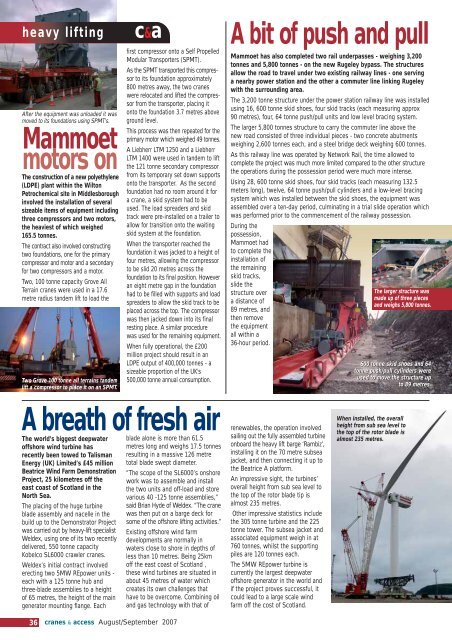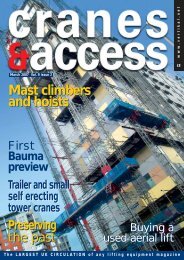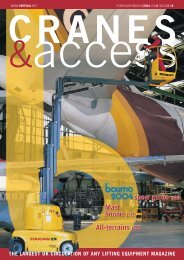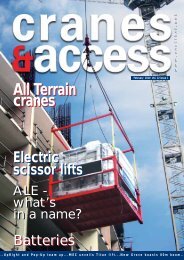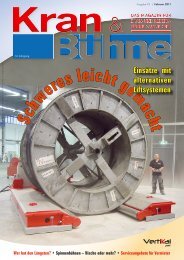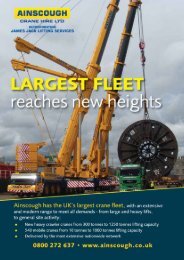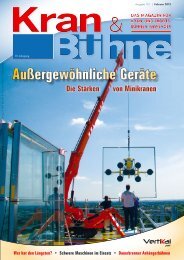c&a - Vertikal.net
c&a - Vertikal.net
c&a - Vertikal.net
Create successful ePaper yourself
Turn your PDF publications into a flip-book with our unique Google optimized e-Paper software.
heavy lifting c&a<br />
After the equipment was unloaded it was<br />
moved to its foundations using SPMT's.<br />
Mammoet<br />
motors on<br />
The construction of a new polyethylene<br />
(LDPE) plant within the Wilton<br />
Petrochemical site in Middlesborough<br />
involved the installation of several<br />
sizeable items of equipment including<br />
three compressors and two motors,<br />
the heaviest of which weighed<br />
165.5 tonnes.<br />
The contract also involved constructing<br />
two foundations, one for the primary<br />
compressor and motor and a secondary<br />
for two compressors and a motor.<br />
Two, 100 tonne capacity Grove All<br />
Terrain cranes were used in a 17.6<br />
metre radius tandem lift to load the<br />
Two Grove 100 tonne all terrains tandem<br />
lift a compressor to place it on an SPMT.<br />
The world’s biggest deepwater<br />
offshore wind turbine has<br />
recently been towed to Talisman<br />
Energy (UK) Limited’s £45 million<br />
Beatrice Wind Farm Demonstration<br />
Project, 25 kilometres off the<br />
east coast of Scotland in the<br />
North Sea.<br />
The placing of the huge turbine<br />
blade assembly and nacelle in the<br />
build up to the Demonstrator Project<br />
was carried out by heavy-lift specialist<br />
Weldex, using one of its two recently<br />
delivered, 550 tonne capacity<br />
Kobelco SL6000 crawler cranes.<br />
Weldex’s initial contract involved<br />
erecting two 5MW REpower units -<br />
each with a 125 tonne hub and<br />
three-blade assemblies to a height<br />
of 65 metres, the height of the main<br />
generator mounting flange. Each<br />
first compressor onto a Self Propelled<br />
Modular Transporters (SPMT).<br />
As the SPMT transported this compressor<br />
to its foundation approximately<br />
800 metres away, the two cranes<br />
were relocated and lifted the compressor<br />
from the transporter, placing it<br />
onto the foundation 3.7 metres above<br />
ground level.<br />
This process was then repeated for the<br />
primary motor which weighed 49 tonnes.<br />
A Liebherr LTM 1250 and a Liebherr<br />
LTM 1400 were used in tandem to lift<br />
the 121 tonne secondary compressor<br />
from its temporary set down supports<br />
onto the transporter. As the second<br />
foundation had no room around it for<br />
a crane, a skid system had to be<br />
used. The load spreaders and skid<br />
track were pre-installed on a trailer to<br />
allow for transition onto the waiting<br />
skid system at the foundation.<br />
When the transporter reached the<br />
foundation it was jacked to a height of<br />
four metres, allowing the compressor<br />
to be slid 20 metres across the<br />
foundation to its final position. However<br />
an eight metre gap in the foundation<br />
had to be filled with supports and load<br />
spreaders to allow the skid track to be<br />
placed across the top. The compressor<br />
was then jacked down into its final<br />
resting place. A similar procedure<br />
was used for the remaining equipment.<br />
When fully operational, the £200<br />
million project should result in an<br />
LDPE output of 400,000 tonnes - a<br />
sizeable proportion of the UK's<br />
500,000 tonne annual consumption.<br />
A breath of fresh air<br />
blade alone is more than 61.5<br />
metres long and weighs 17.5 tonnes<br />
resulting in a massive 126 metre<br />
total blade swept diameter.<br />
“The scope of the SL6000’s onshore<br />
work was to assemble and install<br />
the two units and off-load and store<br />
various 40 -125 tonne assemblies,”<br />
said Brian Hyde of Weldex. “The crane<br />
was then put on a barge deck for<br />
some of the offshore lifting activities.”<br />
Existing offshore wind farm<br />
developments are normally in<br />
waters close to shore in depths of<br />
less than 10 metres. Being 25km<br />
off the east coast of Scotland ,<br />
these wind turbines are situated in<br />
about 45 metres of water which<br />
creates its own challenges that<br />
have to be overcome. Combining oil<br />
and gas technology with that of<br />
36 cranes & access August/September 2007<br />
A bit of push and pull<br />
Mammoet has also completed two rail underpasses - weighing 3,200<br />
tonnes and 5,800 tonnes - on the new Rugeley bypass. The structures<br />
allow the road to travel under two existing railway lines - one serving<br />
a nearby power station and the other a commuter line linking Rugeley<br />
with the surrounding area.<br />
The 3,200 tonne structure under the power station railway line was installed<br />
using 16, 600 tonne skid shoes, four skid tracks (each measuring approx<br />
90 metres), four, 64 tonne push/pull units and low level bracing system.<br />
The larger 5,800 tonnes structure to carry the commuter line above the<br />
new road consisted of three individual pieces - two concrete abutments<br />
weighing 2,600 tonnes each, and a steel bridge deck weighing 600 tonnes.<br />
As this railway line was operated by Network Rail, the time allowed to<br />
complete the project was much more limited compared to the other structure<br />
the operations during the possession period were much more intense.<br />
Using 28, 600 tonne skid shoes, four skid tracks (each measuring 132.5<br />
meters long), twelve, 64 tonne push/pull cylinders and a low-level bracing<br />
system which was installed between the skid shoes, the equipment was<br />
assembled over a ten-day period, culminating in a trial slide operation which<br />
was performed prior to the commencement of the railway possession.<br />
During the<br />
possession,<br />
Mammoet had<br />
to complete the<br />
installation of<br />
the remaining<br />
skid tracks,<br />
slide the<br />
structure over<br />
a distance of<br />
89 metres, and<br />
then remove<br />
the equipment<br />
all within a<br />
36-hour period.<br />
renewables, the operation involved<br />
sailing out the fully assembled turbine<br />
onboard the heavy lift barge ‘Rambiz’,<br />
installing it on the 70 metre subsea<br />
jacket, and then connecting it up to<br />
the Beatrice A platform.<br />
An impressive sight, the turbines’<br />
overall height from sub sea level to<br />
the top of the rotor blade tip is<br />
almost 235 metres.<br />
Other impressive statistics include<br />
the 305 tonne turbine and the 225<br />
tonne tower. The subsea jacket and<br />
associated equipment weigh in at<br />
760 tonnes, whilst the supporting<br />
piles are 120 tonnes each.<br />
The 5MW REpower turbine is<br />
currently the largest deepwater<br />
offshore generator in the world and<br />
if the project proves successful, it<br />
could lead to a large scale wind<br />
farm off the cost of Scotland.<br />
The larger structure was<br />
made up of three pieces<br />
and weighs 5,800 tonnes.<br />
600 tonne skid shoes and 64<br />
tonne push/pull cylinders were<br />
used to move the structure up<br />
to 89 metres.<br />
When installed, the overall<br />
height from sub sea level to<br />
the top of the rotor blade is<br />
almost 235 metres.


